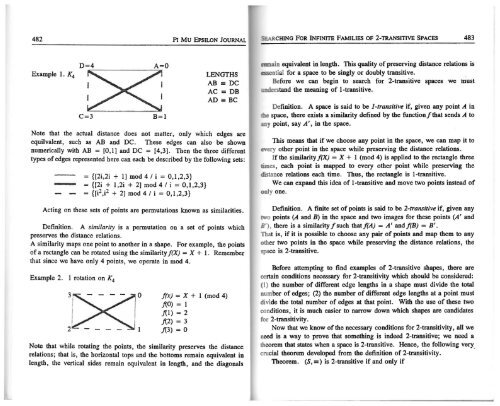Vol. 10 No 6 - Pi Mu Epsilon
Vol. 10 No 6 - Pi Mu Epsilon
Vol. 10 No 6 - Pi Mu Epsilon
- No tags were found...
You also want an ePaper? Increase the reach of your titles
YUMPU automatically turns print PDFs into web optimized ePapers that Google loves.
482<br />
PI MU EPSILON JOURNAL<br />
CHING FOR INFINITE FAMILIES OF 2-TRANSITIVE SPACES 483<br />
Example 1. K 4<br />
C=3<br />
B=l<br />
LENGTHS<br />
AB =DC<br />
AC • DB<br />
AD= BC<br />
<strong>No</strong>te that the actual distance does not matter, only which edges are<br />
equilvalent, such as AB and DC. These edges can also be shown<br />
numerically with AB = [0,1] and DC = [4,3]. Then the three different<br />
types of edges represented here can each be described by the following sets:<br />
= {[2i,2i + 1] mod 4 I i = 0,1,2,3}<br />
= {[2i + 1,2i + 2] mod 41 i = 0,1,2,3}<br />
= {[i 2 ,i 2 + 2] mod 4 I i = 0,1,2,3}<br />
Acting on these sets of points are permutations known as similarities.<br />
Definition. A similarity is a permutation on a set of points which<br />
preserves the distance relations.<br />
A similarity maps one point to another in a shape. For example, the points<br />
of a rectangle can be rotated using the similarity j(X) = X + 1. Remember<br />
that since we have only 4 points, we operate in mod 4.<br />
Example 2. 1 rotation on K 4<br />
0<br />
1<br />
f(x) = X + 1 (mod 4)<br />
ft.O) = 1<br />
.ftl) = 2<br />
.ft2) = 3<br />
.ft3) = 0<br />
<strong>No</strong>te that while rotating the points, the similarity preserves the distance<br />
relations; that is, the horizontal tops and the bottoms remain equivalent in<br />
length, the vertical sides remain equivalent in length, and the diagonals<br />
ranain equivalent in length. This quality of preserving distance relations is<br />
essential for a space to be singly or doubly transitive.<br />
Before we can begin to search for 2-transitive spaces we tnust<br />
rstand the meaning of !-transitive.<br />
Definition. A space is said to be ]-transitive if, given any point A in<br />
space, there exists a similarity defined by the function/that sends A to<br />
y point, say A', in the space.<br />
This means that if we choose any point in the space, we can map it to<br />
every other point in the space while preserving the distance relations.<br />
If the similarity j(X) = X + 1 (mod 4) is applied to the rectangle three<br />
times , each point is mapped to every other point while preserving the<br />
distance relations each time. Thus, the rectangle is !-transitive.<br />
We can expand this idea of !-transitive and move two points instead of<br />
only one.<br />
Definition. A finite set of points is said to be 2-transitive if, given any<br />
two points (A and B) in the space and two images for these points (A' and<br />
B'), there is a similarity/such thatf(A) =A' andf(B) = B'.<br />
That is, if it is possible to choose any pair of points and map them to any<br />
other two points in the space while preserving the distance relations, the<br />
space is 2-transitive.<br />
Before attempting to find examples of 2-transitive shapes, there are<br />
certain conditions necessary for 2-transitivity which should be considered:<br />
(1) the number of different edge lengths in a shape must divide the total<br />
number of edges; (2) the number of different edge lengths at a point must<br />
divide the total number of edges at that point. With the use of these two<br />
conditions, it is much easier to narrow down which shapes are candidates<br />
for 2-transitivity .<br />
<strong>No</strong>w that we know of the necessary conditions for 2-transitivity, all we<br />
need is a way to prove that something is indeed 2-transitive; we need a<br />
theorem that states when a space is 2-transitive. Hence, the following very<br />
crucial theorem developed from the definition of 2-transitivity. •<br />
Theorem. (S, =) is 2-transitive if and only if
















